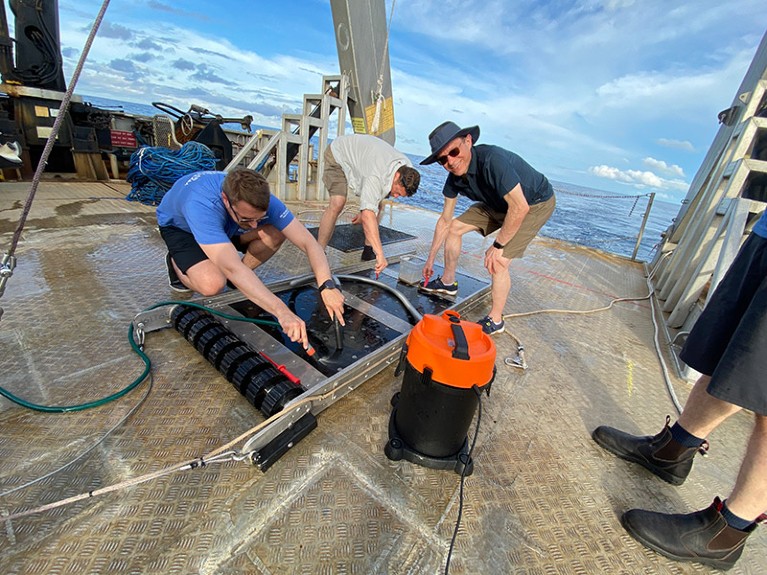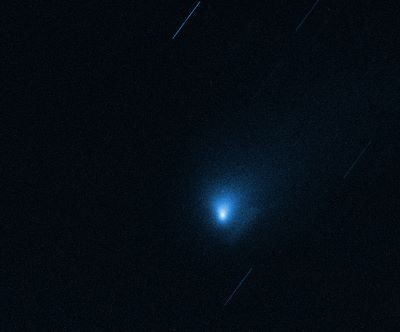[ad_1]

Avi Loeb and his team say that metallic balls found near Papua New Guinea could be of extraterrestrial origin.Credit: Avi Loeb’s photo collection
The Woodlands, Texas
A sensational claim made last year that an ‘alien’ meteorite hit Earth near Papua New Guinea in 2014 got its first in-person airing with the broader scientific community on 12 March. At the Lunar and Planetary Science Conference in The Woodlands, Texas, scientists clashed over whether a research team has indeed found fragments of a space rock that came from outside the Solar System.
An ‘alien meteorite’ probably didn’t slam into Earth — how will we know if one does?
The debate occurred at a packed session featuring Hairuo Fu, a graduate student at Harvard University in Cambridge, Massachusetts, who is a member of the team that found the fragments. Team leader Avi Loeb, an astrophysicist at Harvard who did not attend the conference, has made other controversial claims about extraterrestrial discoveries. Many scientists have said that they don’t want to spend much of their time analysing and refuting these claims.
During his presentation, Fu described tiny metallic blobs that Loeb’s expedition dredged from the sea floor near Papua New Guinea last year, and said that the spherules have a chemical composition of unknown origin1. He then faced questions from a long line of scientists sceptical of the implications of extraterrestrial material. “At the very least, it is something different from what we know,” Fu responded.
New work questions the team’s findings. In a manuscript posted on the arXiv preprint server on 8 March2, ahead of peer review, a researcher argues that the debris collected by Loeb and his co-workers is actually molten blobs generated when an asteroid hit Earth 788,000 years ago.
“What they found has all the characteristics of microtektites — little pieces of melted Earth that came from this impact,” says preprint author Steve Desch, an astrophysicist at Arizona State University in Tempe.
Meanwhile, other studies are challenging different aspects of Loeb’s claim, such as whether the meteor that reportedly produced the fragments was on the trajectory Loeb says it was. Together, the findings show how the broader scientific community is engaging with Loeb’s extraterrestrial claims, in spite of reluctance to do so.
A unique find?
‘Interstellar’ objects remained in the realm of theory until 2017, when astronomers spotted the first known celestial object to be on a trajectory that meant it could only have come from outside the Solar System. Loeb made headlines when he speculated that the object, a comet-like body named ‘Oumuamua, was an artefact sent by an extraterrestrial civilization.
‘Oumuamua passed through the Solar System far from Earth, but Loeb hoped to find another interstellar object that had hit the planet. He later proposed that a bright meteor that appeared in the sky north of Papua New Guinea in January 2014 had an interstellar trajectory and could have scattered debris in the ocean.

Avi Loeb (in hat) and colleagues recover particles from a magnetic sledge on their 2023 expedition.Credit: Avi Loeb’s photo collection
In June 2023, Loeb led a privately funded expedition to the site that used magnetic sledges to recover more than 800 metallic spherules from the sea floor. About one-quarter of the spherules had chemical compositions indicating that they came from igneous, or once-molten, rocks. Of those, a handful were unusually enriched in the elements beryllium, lanthanum and uranium. The researchers concluded that those spherules are unlike any known materials in the Solar System1.
However, Desch counters that the spherules could have come from an asteroid impact in southeast Asia. Key to his proposal2 is a kind of soil called laterite, which forms in tropical regions when heavy rainfall carries some chemical elements from the topmost layers of soil into deeper ones. This leaves the upper soil enriched in other elements, including beryllium, lanthanum and uranium — similar to the composition of the spherules collected by Loeb and his colleagues. Desch says that an asteroid known to have struck the region around 788,000 years ago3 probably hit lateritic rock and created the molten blobs found by Loeb’s team.
In an e-mail to Nature, Loeb argues that spherules from an impact 788,000 years ago should have been buried by ocean sediments. Desch counters that sedimentation rates are relatively low in the offshore area where the spherules were collected.
But others are sceptical of Desch’s proposal, too. Scientists have yet to find any confirmed tektites from lateritic rock, notes Pierre Rochette, a geoscientist at Aix-Marseille University in Aix-en-Provence, France, who is not affiliated with either team. And very few tektites are magnetic, he says, so it would be difficult for Loeb and his colleagues to have pulled up hundreds from the sea floor.
Fiery critiques
Desch was not the only scientist to challenge Loeb’s work this week.
How two intruders from interstellar space are upending astronomy
After Fu’s conference presentation, Ben Fernando, a seismologist at Johns Hopkins University in Baltimore, Maryland, spoke and took aim at claims concerning the 2014 meteor. Fernando and his colleagues, including Desch, analysed seismic and acoustic data gathered by ground-based sensors at the time the meteor hit the atmosphere4. Data from a seismometer on nearby Manus Island, which Loeb and his team studied as they were deciding where to dredge, show no characteristics of a high-altitude fireball — but do indicate a vehicle driving past, Fernando said. “This is almost certainly a truck,” he told the meeting. A second set of observations, made using infrasound sensors that listen for clandestine nuclear tests, seems to have detected the meteor hitting the atmosphere, but suggests it happened around 170 kilometres away from where Loeb’s team calculates.
Loeb told Nature that such critiques do not take into account US Department of Defense data that he says confirm the exact trajectory of that fireball. But because those data are held by the government, they have not been independently cross-checked by other scientists.
As conference-goers poured out of the room after his talk, Fu told Nature that Loeb’s team is working on further analyses, such as isotopic studies, that could shed more light on what the spherules are. After that, Fu said, he is looking forward to graduating and working on a new project — on how the Moon was formed.
[ad_2]
Source Article Link




